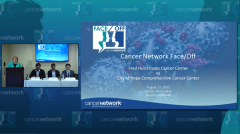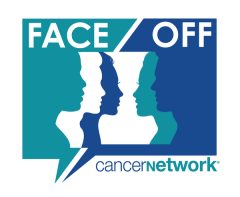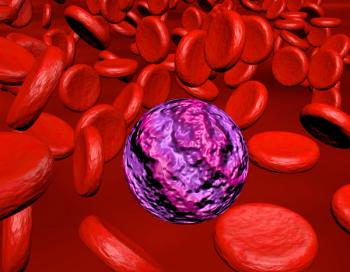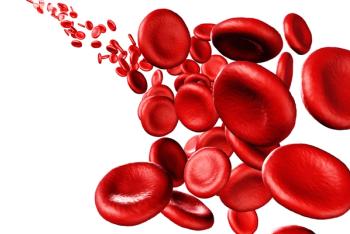
Cross Q&A: Dosing Ponatinib in CML to Balance Efficacy and Cardiovascular Safety
Experts discuss dosing strategies and risk factors for arterial occlusive events in ponatinib treatment for chronic myeloid leukemia, emphasizing the importance of balancing disease control and patient safety.
Episodes in this series

Transcript:
Vivian G. Oehler, MD: Thanks, Paul. You had the lion’s share of the work here. So…I’ve just realized how little I actually know about multiple myeloma. So many of you, because we live in the academic world of the superspecialists, you’re probably like, “OK, so this drug looks a little scary. Why do we need this drug?” Many of our patients do really well, and we have normal life expectancy as the norm for chronic-phase CML [chronic myeloid leukemia]. But ponatinib came down the pike to treat T315I-mutated CML, and [before] we had nothing but transplant. And we also know there’s this group of very resistant patients, especially those without mutations, who generally may not respond to sequencing of drugs.
Into this space, we initially got ponatinib in this resistant patient population in the [phase 2] PACE study [NCT01207440]. And I will say that as CML researchers,…we were taken aback by this arterial occlusive event [AOE], which is this fancy term we use as a hematologist to actually describe patients with cardiovascular, cerebrovascular, and peripheral arterial vascular events. And it came out, actually, after the drug was approved, and so we’ve learned that we actually need to incorporate exactly like this adjudication committee. We need cardiologists, we need neurologists, we need vascular doctors to help us decide what the real things are.
So, when the label first came out, we had over 30% of patients having arterial occlusive events, and sometimes these are actually serious arterial occlusive events, and that was actually something that came out of Dr Koller’s excellent first presentation. AOEs were lower, but serious AOEs still occur. And so, it becomes very difficult, I think, for practitioners. We know that CML can be a scary disease because the resistant patients may need transplant and maybe want to avoid transplant. We want to give normal life expectancy, but if my patient has an MI [myocardial infarction] or a stroke, and this has personally happened to me, on a TKI [tyrosine kinase inhibitor], then that life has been altered. So I really think this first abstract, Dr Koller, that you so wonderfully presented, is actually really important.
[I’ve got] one question…for you. Clearly, the number is lower…. Well, we started originally at 30%, we got down to 22%, and then in your abstract we’re down to 16%. Many of them are serious, but most patients didn’t die of it. Actually, most patients were able to continue ponatinib in this with relatively rare recurrent events. And that figure at the very end of the paper where I think these events are decreasing as the years go by, that puzzled me a little bit because I don’t think we understand the mechanism. I’d love your insights on this, Dr Koller. Why would it necessarily go down? Do you think it was…a numbers thing, where they just had fewer patients to follow further out for this? Or…in your heart of hearts, do you really feel that you need to be less cautious once you enter years 5 and 6 of ponatinib use?
Paul B. Koller, MD: Great question. I don’t think you should be less cautious as it goes on. I suspect that there were [fewer] patients out there. And if you look at the PACE data, there were a lot of dose reductions for other reasons. And I think the [phase 1] OPTIC study [NCT03748784] was a really nice study, in my opinion, that does show that the dose reduction has a big impact on…preventing [this] and not having this event happen. And…I really suspect it’s not really going down. I think what you can say is it’s…maybe not going up, but I don’t know if you can say it’s…going down.
Vivian G. Oehler, MD: I would agree. So, I’m still like, question mark, pay attention. And actually, that’s exactly why OPTIC was designed…. Both of us participated in the PACE study, and we had dose reductions. And we know that patients, once they achieve certain responses, those were actually durable. And for those in the audience, that 1% number is actually important because less than 1% is generally associated with a really big long-term survival benefit. So, we…want to get you to response, and then we reduce the dose.
So, Dr Koller…the PK [pharmacokinetic] studies would suggest that [regarding] T315I, you need a higher dose of ponatinib to treat T315I. And when they pulled that out, we definitely saw more major molecular response in the 45 mg, and then it dropped rather precipitously in the 30 mg and 15 mg cohorts versus the nonmutated cohorts or other mutation cohorts. Has that impacted how you’d select dose for the T315I patient?
Paul B. Koller, MD: In terms of the starting dose…when my colleagues asked me what dose they start ponatinib at…it may be the opposite, like if the person doesn’t have the mutation and has cardiovascular risk factors…. This is all a risk-benefit [decision]. So…what are you more worried about happening to the patient? Is the CML going to be a bigger problem, or is the cardiovascular event going to be a bigger problem? I think I try to start people on 45 mg. I know all my colleagues don’t. They will start people on 30 mg. And I think you could make the argument if the cardiovascular risk factors are higher than the CML [risk factors], at least now, we have more options to salvage after ponatinib. Honestly, it seems like my use of ponatinib has almost increased in the last few years for a variety of reasons. But it’s kind of the opposite, I think, the label now is like 45 mg to 15 mg, and I’m…comfortable with that.
Vivian G. Oehler, MD: What I’m hearing is if somebody doesn’t have a mutation, you actually might start 30 mg, knowing that it’s just easier to tolerate, and we also know that’s a little bit lower for these AOEs too. I think I share that [approach]. When I saw the T315I data, it made me…swallow a little bit because I agree, higher doses, clearly it was twice as high…in the OPTIC study, if you started at 45 mg [instead of] 15 mg. But then for T315I, it didn’t look that way, and…I might start 30 mg just because there’s all-over body aches, and the dry skin and the dry eyes can be really miserable. And so, in my own practice over the years, I’ve always reached for 30 mg. But, seeing the T315I data made me think a little bit about the 45 mg dose, too.
Transcript is AI-generated and edited for clarity and readability.
Newsletter
Stay up to date on recent advances in the multidisciplinary approach to cancer.




















































































